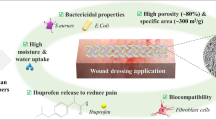Abstract
Composite nonwovens were prepared by the lamination of polypropylene spunbond nonwoven with carboxymethyl cellulose/hollow viscose rayon blend nonwoven and their various properties, such as liquid handling properties, wet tensile strength, moisture evaporation rate, and in-vitro cytotoxicity, were evaluated for moist wound dressing applications. Fluid retention capacity, wet dimensional stability, and wet tensile strength of carboxymethyl cellulose/hollow viscose rayon nonwoven were significantly improved by the lamination with polypropylene spunbond nonwoven. The polypropylene spunbond nonwoven layer did not affect the liquid spreadability and moisture evaporation. The composite nonwoven was not cytotoxic. Considering liquid handling properties and wet properties, composite nonwoven, in which polypropylene spunbond nonwoven on both sides of carboxymehtyl cellulose/hollow viscose rayon nonwoven, was found to be the most desirable wound dressing material of those assessed in this study.
Similar content being viewed by others
References
A. G. Haddad, G. Giatsidis, D. P. Orgill, and E. G. Halvorson, Clin. Plast. Surg., 44, 627 (2017).
M. N. Queiroz, R. A. Araujo, A. F. Rubira, and R. Silva, J. Colloid. Interf. Sci., 106, 533 (2019).
Q. Lei, Z. Li, R. Xu, Y. Wang, H. Li, Y. Wang, M. Liu, S. Yang, R. Zhan, J. Zhao, B. Liu, X. Zhang, W. He, J. Wu, H. Xia, and G. Luo, RSC Adv., 101, 99595 (2016).
H. M. Fahmy, A. A. Aly, and A. Abou-Okeil, Int. J. Biol. Macromol., 114, 929 (2018).
S. Thomas and M. Uzen in “Advanced Textiles for Wound Care”, 2nd ed. (S. Rajendran Eds.), Vol.12, pp.23–54, Elsevier, Amsterdam, 2019.
S. Ghalei, J. Nourmohammadi, A. Solouk, and H. Mirzadeh, Colloid. Surface B., 82, 172 (2018).
S. W. Ali, M. Shahadat, P. Sultana, and S. Z. Ahammad in “Advanced Textiles for Wound Care”, 2nd ed. (S. Rajendran Eds.), Vol.12, pp.489–508, Elsevier, Amsterdam, 2019.
S. Dhivya, V. V. Padmaand, and E. Santhini, Biomedicine (Taipei), 5, 22 (2015).
M. T. Khorasani, A. Joorabloo, A. Moghaddam, H. Shamsi, and Z. Mansoorimoghadam, Int. J. Biol. Macromol., 114, 1203 (2018).
Y. Barnea, J. Weiss, and E. Gur, Ther. Clin. Risk. Manag., 6, 21 (2010).
S. Hu, X. Cai, X. Qu, B. Yu, C. Yan, J. Yang, F. Li, Y. Zheng, and X. Shi, Int. J. Biol. Macromol., 123, 1320 (2019).
Y. N. Yoon, J. N. Im, and S. J. Doh, Fiber. Polym., 14, 1012 (2013).
M. J. Waring and D. Parsons, Biomaterials, 903, 9 (2010).
W. Roggenstein, Lenzinger Berichte, 89, 72 (2011).
P. Wimmer, Lenzinger Berichte, 91, 61 (2013).
M. Einzmann, J. Schmidtbauer, B. Schachtner, and S. Jary, Lenzinger Berichte, 84, 42 (2005).
G. H. Kim, J. H. Youk, Y. J. Kim, and J. N. Im, Fiber. Polym., 17, 1104 (2016).
S. Jackson, J. Lovett, and C. Stephenson, “An Assessment of the Conformability of Superabsorbent Dressings”, Wounds UK Annual Conference, 2016.
B. Tao and X. Wang, U. S. Patent, 2015/0335492 (2015).
W. Li, J. Zhou, and Y. Xu, Biomed., 3, 617 (2015).
S. Vieira, A. R. Franco, E. M. Fernandes, S. Amorim, H. Ferreira, R. A. Pires, R. L. Reis, A. Martins, and N. M. Neves, Colloid. Surface B., 167, 310 (2018).
T. H. Kim, I. K. Park, J. W. Nah, Y. J. Choi, and C. S. Cho, Biomaterials, 25, 3783 (2004).
K. G. Harding, Int. Wound. J., 5, iii–12 (2008).
S. Thomas, J. Wound. Care, 7, 327 (1997).
E. Vorbeck and A. Marine, “Polysaccharide Based Gel-Forming Dressing Manages Leg Wounds without Shrinkage of Dressing and Dressing Disintegration”, SAWC Fall Conference, 2013.
K. Cutting, Br. J. Community Nurs., 8, 3 (2003).
M. Butcher, “The Management of Skin Maceration”, Nursing Times, Vol. 96, p.35, EMAP Publishing Ltd. Co., London, 2000.
T. Heinze and A. Koschella, Macromol. Symp., 13, 223 (2005).
A. Grande and D. Sivakumaran, “Assessment of the Wet Strength and Log Reduction Capacity of a Silver Alginate Dressing”, SAWC Fall Conference, 2013.
M. Wynne, “The Wound Healing Process”, p.298, Health Service Executive National Wound Management Guidelines, 2018.
M. E. Hiro, Y. N. Pierpont, F. Ko, T. E. Wright, M. C. Robson, and W. G. Payne, ePlasty, 12, 409 (2012).
Acknowledgment
This study was financially supported by the National Research Foundation of Korea (EO190003).
Author information
Authors and Affiliations
Corresponding author
Rights and permissions
About this article
Cite this article
Kim, Y., Doh, S.J., Lee, G.D. et al. Composite Nonwovens Based on Carboxymethyl Cellulose for Wound Dressing Materials. Fibers Polym 20, 2048–2056 (2019). https://doi.org/10.1007/s12221-019-9261-9
Received:
Revised:
Accepted:
Published:
Issue Date:
DOI: https://doi.org/10.1007/s12221-019-9261-9




